Slots odds are a topic of huge controversy. Let’s explore the design, diversity, privacy, brevity, and big win allure of the game.
In this guide Prof. Catalin Baroianu, PhD will cover the mathematical and design concepts behind slot machines in a simple, concise matter.
Here’s what you’ll learn:
Let’s get started.

Slots are a game of the extremes: The highest jackpots in the history of gambling – in the order of tens of millions – were won at (progressive) slots.
Slots are the only casino game whose inner configuration and design are kept secret by their producers.
Slots are recognized by problem-gambling experts as the game of chance carrying the highest risk for their players to develop an addictive gambling behavior.
With such features, the game of slots have a special status among the casino games and this is why slot players have to get informed about the insights of slots as a first requirement for a responsible safe play.
When staying in front of a slots machine and enjoying its interface, we see a line or grid of spots where the outcome of the game is displayed after a spin as combinations of symbols.
This is what we call the symbol window.
Additionally, there is a pay window where the winning combinations are defined and assigned a payout rate each (also called the payout schedule or table).
These are the two main components of a slots machine sharing information about the game – the former is about what you get as outcome and the latter about how much you get as prize.
Keep in mind
When a winning combination occurs on a given payline you are paid your stake (the credit you inserted for that spin) multiplied by the payout rate associated with that combination.
The Slot Machine Interface
The slot interface shows you the rules of the game, however to be completely informed about the game you play you should also know what in behind that interface, that is, how the game is configured.
Each spot on the line or grid in the symbol window is associated with one or more reels, which can be physical or virtual.
The reel consists of a number of stops, which are assigned symbols, per the particular design of that machine.
Fun fact
There are usually 22 stops on a reel for electromechanical slots or 64, 128, or 256 for the virtual reels. The reels of a machine may not have the same number of stops of each reel.
You cannot see an entire reel on the interface (unless you remove the machine’s case, for old mechanical or electro-mechanical slots), but only that stop that is visible on the spot of the symbol window associated with that reel.
After the spin, the outcome consists of the combination of symbols displayed in the symbol window and is determined by the stops that were selected (one per reel) randomly by either the RNG or the mechanical processes of spinning, for (electro)mechanical slots.
Understanding Slot Reels
Classical physical reels of the old slot machines initially had 22 stops and this is the average number of stops that a physical reel can hold, including for second-generation slots (electromechanical).
However, slots producers wanted to have more and more stops added on the reels (for diversity of the symbol combinations, but mainly for statistical profit-related reasons).
With the technological evolution of slots, virtual reels became the main component of a slot machine.
The greatest advantage for the producer was that the virtual reel can have stops in any number.
The virtual reels replaced the physical reels for the third generation of slots (video slots), but the latter were not abandoned entirely and in contemporary electromechanical slots they work together with the virtual reels.
We can only see the physical reels on the interface; however the outcome is determined on the invisible virtual reels:
- The physical reel is designed such that to hold symbols in certain number of instances (possibly only one instance of each, so as to hold as much as possible);
- Each of these symbols are assigned a larger number of instances on the virtual reel;
- Then the virtual reel is mapped onto the physical reel (several stops with the same symbol on the virtual reel are mapped into one stop on the physical reel holding the same symbol).
- The RNG randomly selects a stop on the virtual reel, which commands the physical reel to stop on the mapped physical stop.
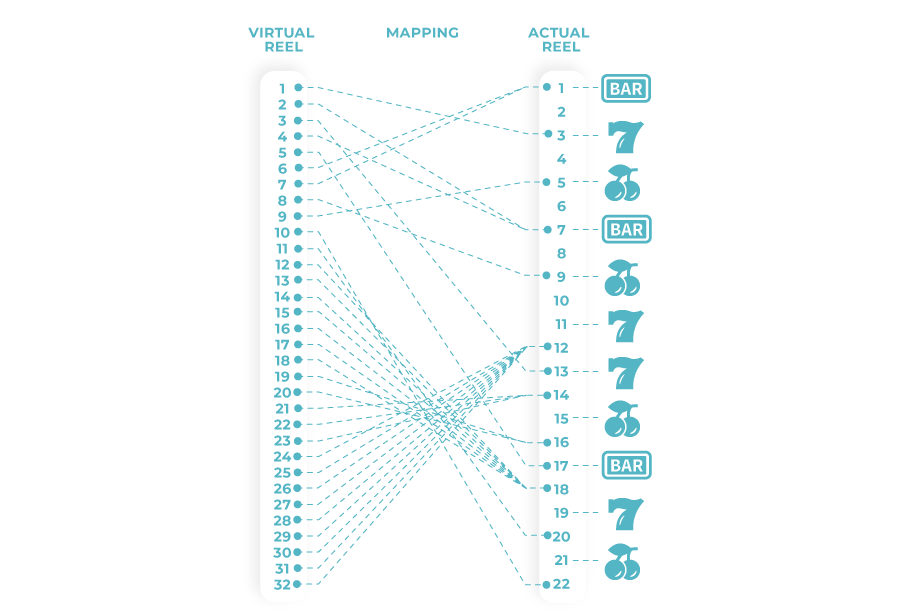
From this description of how a slots machine works one can clearly see what are the parameters that characterize the inner configuration of a slots game:
- the number of distinct symbols (p); symbols denoted

(e.g. cherry, bar, seven, etc.);
- the number of reels (n);
- the number of stops of each reel:

● for each symbol S, the number of instances of S on each of the reels

is the number of instances of symbol

on reel no. j; 1 ≤ i ≤ p, 1 ≤ j ≤ n)
The matrix is called the distribution of the symbols on the reels, commonly called the weighting of the reels. The symbols are distributed on each reel in a certain weighting and arrangement.
Every instance of the above parameters provides a particular configuration of and a distinct slots game.
These parameters are the data necessary for any probability and statistical computation regarding a particular slots game, including the odds of hitting a specific combination that pays out, expected values, and house edge.
In the absence of these data for a particular game, we can only provide general probability formulas with the parameters as variables.
Keep in mind
At modern slot machines, the outcome is determined by the RNG on each of the virtual reels, even though the machine has physical reels.
The number of symbols, of reels, of stops on the reels, and the weighting of the symbols on the reels form the parametric configuration of a game and, which is specific for each game. There is the parametric configuration of a game that is necessary to be known for computing the statistical indicators of that game.

The parameters that determine the inner configuration of a slots game and some basic statistical results are noted in the so-called PAR (Probability Account Report) sheet of that game.
A PAR sheet consists of tables of values.
One table notes the weighting of the reels, that is, how many symbols of each kind is on each reel. The example below is from the PAR sheet of the Bally’s three-reel slots game "In the Money":
| Symbols | R1 | R2 | R3 |
| R7 | Red Seven | 1 | 1 | 1 |
| G7 | Gold Seven | 6 | 6 | 4 |
| 5X | Five Times Bar | 3 | 1 | 1 |
| MU | In The Money Feature | 12 | 12 | 11 |
| MB | In The Money Special Blank | 6 | 6 | 6 |
| 3B | Triple Bar | 8 | 7 | 5 |
| 2B | Double Bar | 8 | 9 | 8 |
| 1B | Single Bar | 8 | 11 | 8 |
| CH | Cherry | 2 | 2 | 2 |
| BL | Blank | 18 | 17 | 26 |
| Total | 72 | 72 | 72 |
| Total Combinations | 373248 |
Symbol weighting in a PAR sheet.
- The 10 distinct symbols of the game are noted in the first two columns (p = 10).
- Columns R1, R2, and R3 hold the weighting of each reel, that is, how many instances of each symbol are on each reel (parameters in our denotation, i from 1 to p).
- The total of these instances on each reel (72) represents the number of stops of each reel.
- The value showing on the row ‘Total combinations’ is the number of all possible combinations of stops (not of distinct symbols) that may occur as an outcome. That number is obtained by multiplication: 72 x 72 x 72 = 373,248.
- Only a part of all these possible combinations are winning and paid out, according to the game’s payout rules.
The winning combinations of symbols are displayed on the paywindow of the interface and the PAR sheet notes them also in a table along with the number of combinations of stops producing them and their associated payout rates:

Table Explaination
In the first column are noted the winning combinations of symbols (in the denotations of the first table), where:
- XB denotes ‘Any Bar’ (3B, 2B, or 1B);
- A7 denotes ‘Any Seven’ (A7 or G7);
- NC denotes ‘Any symbol or blank except a cherry’;
- * indicates a scatter pay.
The column labeled ‘Factors’ notes for every winning combination the number of instances of those symbols on each reel (as stops).
The column labeled ‘Total hits’ notes the number of combinations of those particular stops, which represents the product of the three factors in that line.
For example
The combination (G7 G7 G7) has 6 x 6 x 4 = 144 combinations of stops (called ‘hits’).
The values in the column labeled ‘Actual hits’ correct the ‘Total hits’ values for those combinations holding the multiple elements ‘Any Bar’ or ‘Any Seven’, in order for each combination of stops to be counted only once.
The column labeled ‘1st coin pays’ notes the payout for each winning combination, for one credit wagered.
The column labeled ‘2nd coin pays’ notes the payout for two credits wagered.
The last column notes the total payout of the machine for each winning combination, assuming all hits occurred.
Why the PAR Sheet is Important
With these data available, one can easily figure out the average frequency of a winning combination as the ratio of the values actual hits / total combinations, which is the probability of that combination.
For example
For the combination (3B 3B 3B) – triple bar on each reel – we have 280 actual hits out of 373,248 total combinations and its probability is then 280/373,248 = 1/1,333 = 0.00075 = 0.075%.
You may expect this combination to be hit in average in about 1 to 1,333 spins.
The PAR sheet also notes statistical data, such as the hit frequency, pay frequency, payback percentage of the machine (RTP), and its volatility index, notions that we will talk about in the next section.
Be aware
PAR sheets are kept secret by the slots producers and the only way to retrieve them is by legal intervention or by statistical methods requiring long time tracking and recording.
The latter methods assume the recording of the relative frequency of every symbol on each reel over an extremely long number of spins (in the order of tens of thousands or more).
Then, the approximate number of stops and the weighting of the reels are determined by using numerical techniques of approximation.
Once this parametric configuration is retrieved, all the probabilities and statistical indicators of a slots game can be computed.
Experts and researchers retrieved over time the PAR sheets of many slots games, which are freely available on the internet or in gaming-related publications.
Keep in mind
The parametric configuration of a slot machine and the basic statistical indicators are noted in the PAR sheet of that game, which is usually kept secret by the game’s producer.
Knowing the data in the PAR sheet, one can compute all the statistical indicators of a game, including probability of the winning combinations.
Paylines and Payout Odds
The symbol window of a slots machine consists of a grid of symbol spots, where one or more lines are marked as ‘paylines’.
A line is a path connecting three or more spots and the number of the spots connected is called the length of that line.
One or more spots correspond to a reel.
In video slots, a virtual reel may display several spots, while in large-size grid slots one spot usually corresponds to one reel.
The symbol window displays the outcome of the game after the spin and paylines represent that part of the outcome that determines whether it is winning or losing.
Depending on the game, a player may enable one or more paylines for a spin. For an outcome to be winning, it is necessary that the combination of symbols showing on an enabled payline to match one of the winning combinations defined in the paywindow.
For the first generation of slots, including mechanical slots, the symbol window consisted of one single line, which was also the unique payline, usually with three or five spots.
With the evolution of slots machines, the symbol-window grid increased in size and also the number of paylines, which can have various shapes and orientations:
- horizontal;
- vertical;
- oblique;
- transversal;
- symmetrical;
- triangular;
- trapezoidal;
- zigzag.
Examples of Paylines
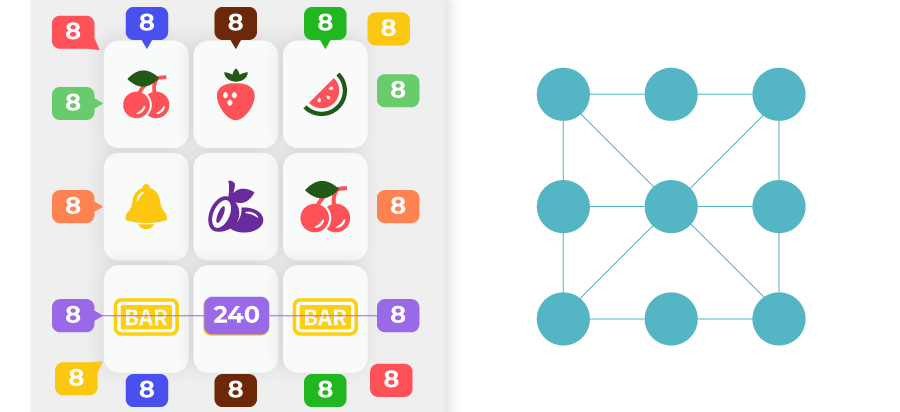
Symbol window of a 9-reel slot machine with 8 paylines of length 3 (horizontal, vertical, and oblique, all transversal), represented as a 3 x 3 grid of spots. Each spot corresponds to a reel.

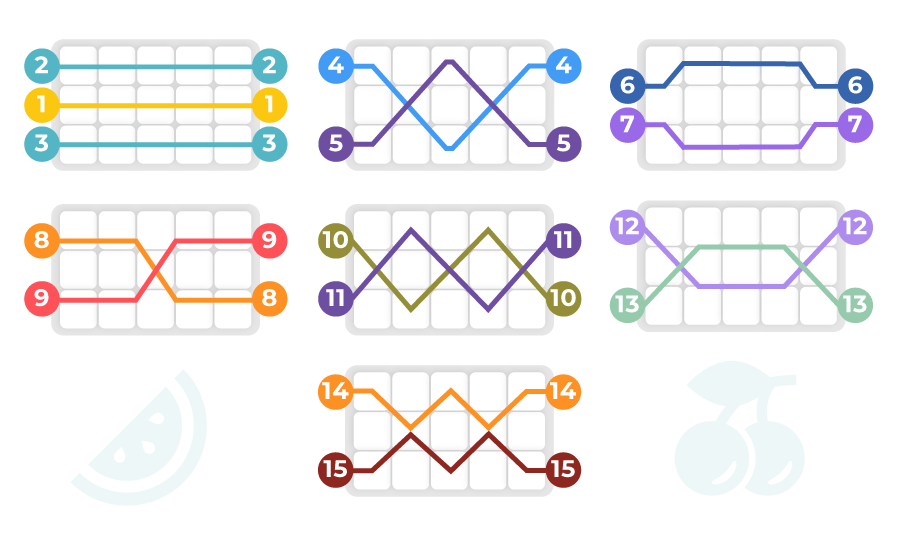
Symbol window of a 5-reel slot machine with 15 transversal paylines of length 5 (horizontal, triangular, symmetrical, trapezoidal, zigzag), represented as a 3 x 5 grid of spots.
Each three adjacent spots as a vertical line correspond to a reel.
Why are Paylines Important?
The complexity of the paylines counts just as diversity and design, features that make the game to be attractive.
From the producer’s standpoint, it is just their length that counts.
Whatever the shape or length of the paylines, most of them are designed to cross entirely over the reels, that is, connecting spots corresponding one to each reel.
As such, the outcome on a payline will be determined by one stop of each reel and, since the reels spins independently, the statistics associated with that outcome will only employ the length of the payline and the symbol weighting of each reel.
Keep in mind
The outcome on a payline consists of the symbols showing on each spot in that payline, each corresponding to a stop of a reel. Whatever the shape of a payline, it’s only its length that counts in the equation of the probability of a winning combination, along with the symbol weighting of each reel.
Understanding Payout Odds in Slots
Each winning combination occurring on a payline has its payout odds assigned in the design of the game.
These payout odds are displayed in the paywindow of the machine in either odds format (for instance, 50 : 1, or ‘50 to 1’), multiplication coefficient (for instance, x50), or payout amount relative to the credit (for instance, 50, corresponding to one credit/coin, and 100, corresponding to two credits/coins).
The table holding the payout odds is also called the payout schedule of that machine.
The common feature of the payout schedules across slots games is that it inverses the order of likelihoods.
The payout odds are approximately inversely proportional to probabilities: the higher the probability of a winning combination, the lower its payout odds.
Let’s take as a concrete example the payout odds of the game In the Money in our PAR sheet example.
Let's take an example. We consider only the winning combinations (R7 R7 R7), (3B 5X 5X), (5X 1B 5X), and (1B 1B 1B). Their payout odds and probabilities are noted in the following table:
| Winning combination | Payouts odds(for 1 coin) | Probability |
| R7 R7 R7 | 1000 | 0.000002679 or 1/373,248 |
| 3B 5X 5X | 500 | 0.000021432 or 1/46,656 |
| 5X 1B 5X | 250 | 0.000088407 or 1/11,311 |
| 1B 1B 1B | 10 | 0.001886016 or 1/530 |
In the example above you may notice that the order of the payouts is reversed for the probabilities.
Also, the payout odds are not even close to the relative frequency expressed by its probability.
For example
The combination (1B 1B 1B) is expected to occur in average about once in 530 spins, however the machine pays only 10 times your credit.
One may fairly perceive that as a skinning of money.
Indeed, if you hit that combination once in 530 spins, there are about 529 non-winning spins and the machine pays you back only 10 out of the 529 credit lost (about 53 times lower than your loss)!
This is a common feature of all the slots game – the payout odds do not reflect the true odds. Plus,the difference between them may vary in whatever range across the various games.
In fact, it is that difference between the two odds that gives the edge for the casino and the producer.
Moreover, payout odds cannot be taken to give any clue or information about the probabilities of the winning combinations, since the former can be hundreds or thousands or more times higher than the latter.
Of course, there are ethical issues with that difference, the more so as you don’t know the true odds since they are kept secret, however no legislation in any jurisdiction regulates over this indicator.
From a mathematical standpoint, there is an indicator measuring this kind of “fairness”, which we will talk about in a further section.
Be aware
Payout odds displayed in the paywindow are not probabilities of the winning combinations. They just express the payout that the game offers if you hit such a combination.
The higher the payout odds, the lower the probability of a winning combination, however payout odds do not approximate to any extent the probabilities of winning.
A random number generator (RNG) is a physical or electronic device or software by which numbers in a certain range or set can be randomly generated.
Here, ‘randomly’ means that any outcome is independent to the previously outcome and the numbers are as much as possible uniformly distributed in the obtained sequence.
The software-based random number generators are also called pseudo-random number generators (PRNG) and works on the basis of algorithms that exploit specific mathematical properties of some functions.
In old mechanical slots and some electromechanical slots, the outcome was determined mechanically, as the result of triggering the mechanism that spins the reels.
Such mechanisms have physical features that provide acceptable randomness for the outcomes of the spins – enough high speed of rotation for each reel, the reels spin independently to each other at some point, and the spins of the reels are out of phase with respect to one another.
It’s like in croupier-spun roulette, where everybody accepts that the spin is random.
The virtual-reel slots and the electromechanical slots with mapped virtual reels need a PRNG instead.
How PRNG Works
Each stop on a virtual reel has a number associated.
The PRNG works for each reel separately and generates randomly numbers from 1 to the number of stops on that reel. The machine commands the reels to stay from spinning with the stops selected by the PRNG in the displayed spots.
As such, the PRNG does not pick symbols on a reel, but stops (holding symbols). A blank on a reel is also a symbol and when the machine displays a blank, the PRNG actually picks a specific blank (that is, the specific stop holding that blank).
The PRNG is working on a continuous basis, even when you are not playing, picking hundreds or thousands of numbers per second. Therefore the outcome is determined before being displayed and is not the result of any physical command of the player (pressing the spin or stop button or pulling the lever).
The PRNG ensures the hypothesis that any combination of stops of the reels (not of symbols) has the same probability of occurrence as outcome (precisely, one in the product between the number of stops on each reel).
The fact that some symbol combinations or symbols occur more frequently than others is related to the symbol weighting of the reels.
Fun fact
In progressive slots, a PRNG has also the role of triggering the progressive jackpot, determining which machine will be the winner.
It works independently of the PRNGs of the machines in the network, within a specific algorithm used for establishing the winner.
For the must-hit-by jackpot system, the PRNG works in general like this: It generates a random number within the entire range of the jackpot amount (minimal to maximal value, as either integers or decimal numbers) or within a chosen interval included in this range, as the triggering point.
For the unlimited jackpot system, the PRNG may generate numbers associated with time intervals, values of the meter, machines, wager amounts, etc.
The specific algorithm of the system combines these inputs to determine when the jackpot will hit; however, such algorithms vary from a system to another and are not known or predictable.
For more details about how a RNG works, see our RNG guide.
Keep in mind
In regular slots, the PRNG works for each reel separately and determines the stops that the reels will display in the symbol window. The combination of symbols occurring after the spin is determined by the symbols associated with the stops randomly selected by the PRNG.
In progressive-jackpot slots, another PRNG works for triggering the jackpot.
Probabilities in Slots
In slots we can talk about the probability of the events related to the winning combinations displayed in the paywindow.
However, we can estimate or compute them precisely only if we have the PAR sheet of the respective game or have retrieved its parametric configuration by statistical methods based on tracking.
Such winning events can be:
- a particular winning combination
- one of several given winning combinations
- any winning combination, on one or several paylines.
Computation of the probability of any such event uses a general formula in combinatorial form:
The probability of an event E occurring on a payline of length n (crossing over n reels) is:

where F(E) is the number of combinations of stops on that payline favorable for the event E to occur, and the indexed ts denote the number of stops of each reel crossed by that payline.
F(E) depends on the other parameters of the game besides the number of stops on each reel (the ts) and n, namely p and =

(see them explained in the first section). F(E) is computed using more or less complex combinatorial formulas, depending on the event in question.
Example
The simplest case for computation is for the event E of hitting the top-award winning combination, consisting on the same top-award symbol on each reel.
For instance, assume a 5-reel machine with 64 stops on each reel, where the top-award symbol (S) has the following weightings on the reels: 1, 2, 2, 3, 1.
The number of combinations of stops favorable for the event is F(E) = 1 x 2 x 2 x 3 x 1 = 12. According to the general formula, the probability for E to occur is 12/(64 x 64 x 64 x 64 x 64) = 0.0000000111.
For combinations involving two or more symbols on the payline, the combinatorial count gets more complicated.
The Relationship between Payout Odds and Probability
As we know now, the probabilities of the various winning combinations or the probability of any event regarding the outcome in slots cannot be computed numerically except if we know in advance the parametric configuration of that game.
Payout odds are not giving any clue for such probabilities either. Yet we can only assume that these probabilities are very low, and the previous imaginary or real examples confirm that.
The more number of stops on a reel and the more reels, the lower the probabilities of hitting the winning combinations.
In particular, the probability of the top-award combination (the regular jackpot) is supposed to be “astronomically low” and for some games its order can be compared with the order of the probabilities for the lottery jackpot (one in millions or in tens of millions).
Just for illustration purposes and not associated with any particular real slot games, I noted in the following table some numerical values for this probability, under the following assumptions: the top-award symbol has only one instance on each reel and the reels have the same number of stops.
Of course, those odds in the order of 1 in billions are not actually associated with existent games, as the top-award symbol usually gets more weighted as the number of reels and of their stops increase.
The idea is that winning odds for top-award combinations can be of any order and the rest of the winning combinations are supposed to have low probabilities as well. In a top of the games of chance with the lowest winning odds, slots share the last place with lottery.
Keep in mind
Probabilities of the winning combinations in a slots game cannot be computed unless we have access to the PAR sheet of the game or retrieve its parametric configuration by statistical methods.
The probability of the top-award winning combination is very low and could be in the order of one in millions or more.
The more reels and stops on the reels, the lower the probabilities of the winning combinations.
Fairness of a Slot Game
What does it mean for a game of chance or a bet to be fair?
Mathematically speaking, a bet is fair only if its expected value would be zero, however you will not see such a bet available in a casino, as zero expected value means zero house edge and the house would make no profit from such a bet over the long run.
On the other hand, a bet is a commercial product like any other so having a house edge in the role of a trade allowance sounds fair enough for that product to stay on the gambling market.
A positive house edge (ensuring the house’s profit) for a bet is the direct result of having the payout odds lower than its true odds (or the inverse of the payout rate higher than the probability of that winning event).
House edge can be taken as a measure for the average fairness of a game, but each particular bet or prize can have its own fairness and this should concern players that chase or aims at specific prizes in a game.
This also applies to slots, where every player aims at either a top prize or a lower ranked prize.
We saw in a previous section how payout odds differ from the true odds of the winning combinations and the magnitude of that difference reflects a measure for a kind of fairness of those payouts.
In gambling mathematics there is a notion that describes the fairness of a bet or of a slots prize.
Slots Bet Fairness Definition
If p is the probability of winning and r the payout rate of a bet, the bet is mathematically fair if r = (1 – p )/p (in this case, r is the fair payout rate).
This is a sufficient condition for the EV to be null. The real fairness f of a bet is the ratio between the actual payout rate r and the fair payout rate: f = rp/(1 – p).
The higher the value of f (the closer to 1), the fairer the bet. Since probability p shows in the expression of f, fairness can be computed only if we know this parameter.
Now, let’s apply this notion to a real slots game, namely Blazing 7s from Quick Casino Slots.
Example of Calculating a Slot’s Fairness
Let’s consider three winning combinations in Blazing 7s.

- The top-award combination is Blazing 7 (B7) - Blazing 7 (B7) - Double jackpot (DJ);
- The second ranked combination in the payout schedule is Blazing 7 (B7) - Blazing 7 (B7) - Blazing 7 (B7);
- A middle-ranked combination is Double bar (2B) - Double bar (2B) - Double bar (2B).
According to the payout schedule and the PAR sheet of the game, the following payout rates and probabilities are associated to these combinations:
| Winning combination | Payout rate(for the 2nd coin) | Probability |
| B7 B7 DJ | x2500 | 0.00001071 |
| B7 B7 B7 | x500 | 0.00024648 |
| 2B 2B 2B | x40 | 0.00194508 |
Now let’s compute the mathematical fairness for each prize:
- For (B7 B7 DJ), mathematical fairness is f = 2,500×0.00001071/(1 – 0.00001071) = 0.0267 or 2.67%.
- For (B7 B7 B7), mathematical fairness is f = 500×0.00024648/(1 – 0.00024648) = 0.1232 or 12.32%.
- For (2B 2B 2B), mathematical fairness is f = 40×0.00194508/(1 – 0.00194508) = 0.0776 or 7.76%.
With these figures, the payout rate of ×2,500 for the top-award combination in our example does not seem like a generous offer any more, right?
Fun fact
As a comparison, a color bet in European roulette (having the probability of winning 48.64% and payout rate ×1) has a mathematical fairness of 94.70%.
While adding a trade allowance to the cost of a product is a fair economic choice, not having that surplus transparent for the customers is no longer a fair commercial practice, especially when that surplus is far higher than for products in the same category.
In slots, the surplus is unknown since we have no access to all parameters of the game.
Mathematical fairness of a bet – assuming known or computable – can be a criterion for choosing a game or another, as are the other statistical indicators of a game.
Keep in mind
Mathematical fairness of a slots prize in a game reflects how different the payout odds of that prize are than its probability (true odds). It is the ratio between the actual payout rate and the ideal payout rate for which that bet would have zero expectation.
The mathematical fairness of a slots prize cannot be computed unless we know the probability of that prize.
When playing slots, you place a bet like in any other game of chance and your bet is that a winning combination of symbols will occur on one or more paylines. This bet has its own expected value, which depends on your stake, the payout odds, and the probabilities associated with each winning combination, per the well-known formula:
EV = probability of winning x profit if you win + probability of loosing x the negative profit (loss) if you loose.
EV can be also expressed in the form of a percentage, as ratio of the initial stake.
Each game of slots has a house edge (HE) defined as the inverse (in sign minus becoming plus) of the expected value of a bet.
The HE reflects the profit of the casino over the long run, as a percentage of all players’ stakes.
Generally, in slots, if

are the winning combinations,

are the probabilities for these combinations to occur on a payline,

are their payout rates respectively, and c is your stake, then:

or, as a ratio of the initial stake:

Again, the only parameters from the above formulas that we can know are the payout odds Oi. For being able to compute the EV and HE numerically, we should know the probabilities Pi.
Understanding Slots RTP
In slots, the house edge is usually expressed not in terms of the house’s profit, but of players’ payouts. The statistical indicator called the Return to Player (RTP), also known as the payback percentage, is defined as

All EV, HE, and RTP are statistical averages that indicate a cumulative result, over the long run.
Mathematically, ‘the long run’ means an infinite series of spins in the same conditions. In reality, the longer the series of spins, the more the cumulated profit or loss come to approach the value of these indicators.
Since the RTP is a statistical average, it should be interpreted as such: The RTP is the percentage of the total amounts wagered that a machine pays back to its players as prizes over the long run.
The RTP of the slot games usually ranges between 80% – 99%, but this high percent should not be interpreted as any gain or advantage for the player.
On the contrary, it reflects an averaged loss, since the RTP is just another way to express house edge: the house edge is 1 – RTP, which is the opposite of the expected value.
For example
A RTP 96% means 4% house edge (higher that the house edge of an European roulette) and –4% expected value, which is the average loss you can expect over the long run.
The RTP is the only statistical indicator that is displayed on many slot machines, in their help/about section (in some rare cases, they also display the volatility index).
Producers reveal the RTP either voluntarily or constrained by the local gambling regulations. However, this information is subject to several and frequent misinterpretations from the players.
Keep in mind
The RTP is a way to express the house edge as one minus the payback percentage, while house edge is the opposite of the expected value. All these notions are statistical averages and only apply in the long run play. Hence the RTP does not express any advantage for the player.
Misinterpretations of the RTP
The RTP is many times the only available statistical information about a slots game and the main criterion for choosing a game or another. Indeed, the higher the payback of a game, the higher the chances for a player to hit some prizes during their session of playing.
We saw in the previous section that the RTP, per its definition, is an abstract mathematical notion, tightly related to the expected value.
When talking about the RTP in non-mathematical context, i.e. the real play, we must have an adequate interpretation of the notion itself and its application.
Unfortunately, many players misinterpret the RTP and by doing this come to have a distorted view on how a slots machine works and the gain they should expect from their play.
The main misinterpretations of the RTP along with their corrections are the following:
RTP as an advantage or gain
Influenced by the word description of the notion and not by the mathematical one, some players perceive the “return” as a kind of expected gain that will add to their wins. The values of this indicator (usually close to 100%) are sometimes perceived as advantageous from the player’s perspective.
The RTP actually reflects the house edge in terms of the players’ payback, hence the RTP actually reflects an average loss and not any gain.
RTP applying to individual sessions or short-run play
Some players think that the RTP can be applied to their own playing session, whatever long, that is, the machine will pay back that percentage from their wagers collected from the moment of start until they stop the session.
Others think that the machine will pay back in that percentage cumulatively to all the players playing that machine over one day or one week or more.The RTP is a statistical average based on probability. In the real play (which is finite) we can only refer to RTP as a limit to approach over the long run, specific to that game.
Therefore any application of the RTP over definite intervals of plays or individual players is inadequate and leads to inaccurate estimations.
Misinterpretations of the RTP messages
When the RTP information is displayed on the showcard of a machine, a classical message like “this machine has an average payback of 95%” can be misinterpreted by non-informed players in various ways, such as:
- 95% of the players of that machine will win some prizes;
- This machine will pay out a prize 19 times out of 20;
- If you bet $1 at this machine you are guaranteed to win 95 cents.
Such misinterpretations are favored by the incorrect understanding of the concept of statistical average, which is in the nature of the RTP.
There are slot machines having different RTPs, depending on the credit.
The variation comes from the extra bonuses and different payout odds that the game offers for higher credits. The RTP messages of such machines (noting the different values of the RTP) can be misinterpreted as well and the most common misinterpretation is “the higher the stake, the higher the chances of winning”, which is false.
Keep in mind
Whatever the stake, the winning probability is the same, but the payout rate is higher for higher stakes, which is reflected in the associated RTP.
Be aware
The RTP should be interpreted as a way to express the house edge and is a statistical average. It does not reflect any average gain or profit, but the average loss. Applying it to one single player’s play or over short-run play of one or several players is incorrect. The RTP is not a kind of probability or payout odds and does not express any average frequency of the wins.
If the combinatorial probability formula and other notions we provided in previous sections still seem complicated for the non-math reader, they can be expressed in technical terms commonly used in the slots jargon:
Cycle
The number of all possible combinations of stops that may occur as outcomes on a payline in a slots game.
It represents the denominator of the fraction in the combinatorial formula, namely the product of the number of stops of the reels (the ts in that formula).
Hits
The number of combinations of stops holding a given winning combination of symbols. It represents the numerator of the fraction in the probability formula.
In these terms, the probability formula is written as:
probability (of a given winning combination) = hits/cycle
The cycle can be interpreted as the number of spins in which every combination of stops occurs only once, while the hits are the number of occurrences of the given winning combination over that cycle.
Hit rate
The relative frequency of a given winning combination over the long run.
hit rate = 1/probability = cycle/hits
Hit frequency
The hit rate expressed as percentage: hit frequency = 100%/hit rate
Average win
The expected value for each prize in the payout schedule over the long run.
Average win = prize × probability (of that prize)
Payback percentage (RTP)
This is defined as: RTP = (average win/average stake) × 100%
Volatility is a term reflecting in practice the statistical notion of variance.
Variance is a measure for the deviation of the values of the random variable from the mean or expected value as an average of their squared deviation.
It measures how the data are spread out from their mean. In gambling terms, variance gives a measure of how often on average the game pays back, as well as of how the prizes are distributed.
Keep in mind
In gambling jargon, the term volatility is used as related to variance, especially in slots.
Volatility is variance over a definite interval of time or number of spins, and it is often expressed on a 1-to-5 or 1-to-10 scale.
It is also usually labeled as low, medium, or high.
In general, in low-volatility slots, you can expect more frequent wins and in smaller amounts than in high-volatility slots, where you may wait longer before hitting a prize.
Volatility directly depends – as any other statistical indicator – on the parametric configuration of the game.
Some slots producers expose the volatility index of their games along with the RTP, but the most of them do not.
For the latter, you have to figure out whether it is about a low-, medium-, or high-volatility game.
The payout rates may give you a clue about the volatility category of a game: Usually the slot games offering high payout rates for their top-award combinations (×5,000, ×8,000, etc.) or having a big difference between the lowest and the highest payout rate are high-volatility games.
Games offering bonuses (free spins, additional payouts, etc.) are also likely to be high-volatility games.
A more precise method of finding the volatility of a game is through statistical tracking over the long run.
Keep in mind
The volatility of a slots game is a statistical indicator measuring how often on average the game pays back its players, as well as of how the prizes are distributed, over a definite number of spins.

In gambling, a near miss is a non-winning outcome differing in one or a few elements from a winning one.
It is a failure that looks close to being successful and occurs in every game of chance.
Every gambler experienced the near-miss in their gambling history.
Problem gambling experts claim that the near-miss is a risk factor for developing a problematic gambling behavior.
That's because this phenomenon is followed by what they call ‘the near-miss effect’ – a combined emotion of frustration and hope (“I was that close!”) which fuels the belief that a win is imminent and there are good chances for that to happen if enough dedication is given to the game.
The near-misses may occur by pure chance – for instance, busting in blackjack with 22 points, or rolling a 12 instead of 11 in craps, and so on.
But there are also near-misses where chance is not the only factor determining their occurrence and their effect.
For example
A scratch-card ticket displaying two identical award symbols and one missing on a line (to be winning) and another such symbol adjacent to the spot where missing for a win, is a kind of near-miss whose effect is amplified by the special design of that ticket.
Such near-misses are called artificial or engineered near-misses.
Artificial near-misses occur in slots and such facts are the result of the inner design of the games.
By the nature of slots, the game parameters can be manipulated in the design phase so as to result in frequent outcomes looking like near-misses and interpreted by players as chance near-misses.
The classical near-miss in slots is when a symbol is missed on a payline for having a winning combination.
However, for the games displaying grids of spots in their symbol window, the near-miss and the near-miss effect can be also related to elements outside the actual outcome on the payline:
It may happen that instances of the missing symbol on a payline to occur as just below or above that payline, or to the left or to the right of it. This extended outcome is perceived like a near-miss.
The Award Symbol Ratio and Clustering
The artificial near-miss can be designed to occur frequently on the payline, by choosing specific weightings for each reel.
For instance
On a 3-reel machine, a symbol determining a top-prize combination (one on each reel) is weighted in a high ratio on two of the reels and in a very low one on the third. As such, it will occur frequently on two reels, creating the illusion of a chance near-miss.
This technique is called award symbol ratio.
The technique for creating artificial near-misses adjacent to the payline is called clustering and relies on the flexibility of the symbol weighting and arrangement on the virtual reels.
The basic idea is to place a stop with a high-award symbol on the virtual reel between several stops with low-award symbols or blanks, mapped into the corresponding positions on the physical reel or the virtual reel visible in the symbol window.
With the clustering technique, the real chances that the RNG will pick a certain symbol on the visible reel are different than the odds given by the actual weighting of that symbol on that reel.
In fact, the low-award immediately above and below the high-award symbol are favored on the physical reel.
Hitting these symbols gives players the illusion that they almost hit the high-award symbol, because that symbol is physically close to the payline.
But it is not mathematically close – any combination of stops (on the virtual reels) has the same probability of occurrence and not any combination of symbols.
As such, an artificial near-miss is just a miss and has nothing special except the design effort spent for creating that illusion.
“I was that close” is actually “I was as far as with any other losing combination”, where “far” should me measured in probability and not in the number of symbols missing for a prize.
Be aware
In modern slots, artificial near-misses can be created by manipulating the symbol weightings on the reels in the game design. This causes certain symbol combinations looking like chance near-misses to occur frequently.
For either chance or artificial near-misses, you should take that combination to be just losing and not near-missing a winning one.
If you hit a near-miss, this does not mean that your chances to hit a prize with the next spins increase (as every spin is independent of another), nor does indicate that those chances are high.
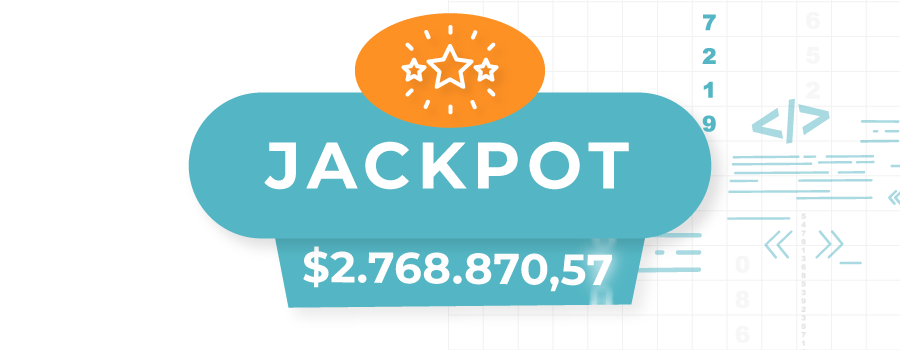
A progressive jackpot is a kind of prize that accumulates in time, increasing with every new spin, and is released as one single prize to the winner, by the rules in force for that system and casino.
In most of the progressive systems, there are eligibility requirements for a player to be awarded the progressive jackpot – usually they are required to hit the top-prize of the game (the regular jackpot) or in some cases any prize; most of the systems require the players to place bets of a certain size to be eligible.
There are 3 major categories of progressive slots:
- Standalone progressives – individual slots machines (physical or virtual) that accumulate funds for the progressive jackpot only from their own wagers.
- Local progressives – a network of 10 up to 100 physical machines in a casino, where every player at any machine in the network participates to the jackpot fund.
- Wide-area network progressives – a network of machines (physical or virtual) across several casinos, online or physical, working in different places, possibly all over the globe.
Each progressive-jackpot system has its own characteristics and rules.
In all systems, the jackpot begins to accumulates with the first bet placed on a machine (individual or in network) after the previous jackpot has been released, and it will be available for a new release only after the jackpot amount reaches a certain threshold, called the seed.
The current value of the jackpot is called the jackpot meter and is displayed on all machines in the network.
The contribution to the jackpot fund may be either by bet or by win and is setup as a percentage of the wagers or wins that is directed toward the jackpot.
The by-bet contribution makes the meter increasing with every new spin, while the by-win contribution makes it increasing with every new win.
There are two types of progressive systems with respect to the release of the jackpot:
The must-hit-by jackpot (also called mystery jackpot) has a maximal value associated and can be released anytime between the seed and that maximal value.
The release point is determined randomly by the RNG after each reset of the meter and the winner will be that player whose contribution to the jackpot fund makes that release value to be met or exceeded.
The unlimited progressive system do not have an upper limit for the jackpot and it could be won at anytime after the seed is passed, if the eligibility requirements are met.
This is why the meter of such systems may come to reach amounts in the order of millions and tens of millions, for the wide-area network progressives.
Besides the parameters of the individual slot machines in a progressive network, the network itself has its own parameters and statistical indicators and most of them are not known for the public (such a popular feature for slots!).
Keep in mind
In progressive slots, the progressive jackpot is variable and increases with every spin from either players’ wagers or wins. It is a kind of side bet in slots. There are several types of progressive systems in slots.
Parameters and Statistical Indicators of a Progressive System
The percentage of the wagers or wins that is directed toward the jackpot is called the rate of the meter rise.
The rate of the meter rise is specific to each system and common values of it are 1% or 2%, but there are also systems with a rate of under 1%.
The rate of the meter rise r of a progressive is not exposed, but it can be retrieved through tracking and counting.
For per-bet contribution progressives, you have to find out how much it takes to move the meter 1 cent either by playing the game yourself or by watching someone else playing.
If c is the credit wagered and a is the meter advancement, then the rate of the meter rise is r = 100 x a / c (%).
For example
If your stake of 50 cents moves the meter with 1 cent, then r = 100 x 1 / 50 (%) = 2%.
Such a method of retrieval works fine for a standalone progressive, relatively fine for a local progressive.
However, for a wide-area network progressive it might be subject to errors and inaccurate approximations (since you don’t know if more than one player contributed to the meter advancement).
As for the per-win progressives, the method requires a far longer period of observation.
Another parameter is the seed, which is also kept secret for most of the systems.
The only parameter exposed is the must-hit-by value M for the mystery jackpot, that is, the maximal possible value for that progressive jackpot.
We saw that the RTP of a non-progressive slot machine is defined as the average win / average stake.
Still, at a progressive there is the progressive jackpot that adds to the wins given as the base prizes.
We don’t know when the jackpot will be released, nor in what amount.
We just know that at some future moment the release will happen. Therefore, at a progressive the actual RTP including jackpot is higher than the regular RTP of the machines in the network.
Since the jackpot increases with every bet and it is not known when it will reset, we can say that the RTP of a progressive system is variable.
Unlike the regular RTP, which is constant for a machine, the progressive RTP should be meant as depending on the meter: it expresses the average payback percentage over the long run at the moment of estimation, under the assumption that the jackpot amount would remain at its current value.
So the payback percentage increases from the regular RTP upward, as the jackpot increases.
But the RTP is a percentage under 100%, hence at a certain value of the meter, the progressive RTP will equal 100% and then will go beyond that figure. This is the moment when the expected value is zero and gets positive after this moment until the jackpot resets.
That moment is called the breakeven point of the progressive system and is an important statistical indicator of it, as it is the only one associated with a strategic play in progressive slots.
Keep in mind
An important parameter of a progressive system is the rate of the meter rise, namely the percentage of the player’s wagers or wins that are directed to the progressive jackpot. This parameter is not exposed, but it can be retrieved through statistical methods.
The RTP of a progressive system is not known and cannot be computed. All that we know about it is that it is higher than the regular RTP of the machines in the network and increases with the jackpot.
Breakeven Point and Advantage Play in Progressive Slots
The breakeven point of an unlimited progressive system cannot be computed, even if we knew the regular RTP, as long as we know nothing about the algorithm of triggering the jackpot.
Instead, the breakeven point can be estimated roughly for the must-hit-by progressive systems, if we know the regular RTP and the rate of the meter rise r, assumed per bet and not per win.
Another assumption for making this computation possible is that the algorithm triggering the jackpot randomly selects a number from a uniform distribution of the amounts on the meter range.
In these conditions, the following rule of thumb gives us an approximated value for the amount on the meter corresponding to the breakeven point:
B = M x (1 – RTP + r) / (1 – RTP + 2r), where M is the maximal value of the jackpot.
Example
A must-hit-by progressive system with slot machines with a regular RTP of 90%, a rate r of 2%, and a maximal value of the jackpot of $4,000, would have the breakeven point somewhere near B = $4,000 x (1 – 0.88) / (1 – 0.86) = $3,428.
Keep in mind
In progressive systems, there is a value on the meter for which the expected value of your bet is zero and positive beyond it – the breakeven point.
In unlimited jackpot systems, the breakeven point cannot be determined, but in must-hit-by progressives it can be estimated basing on some idealizations, provided that the RTP is known.
Strategic Considerations for the Breakeven Point
The breakeven point has a strategic significance in must-hit-by progressives.
A positive expectation of a bet means that if you place that bet in the same circumstances over the long run, you are expected to win cumulatively more than you will loose with that bet.
In progressive slots, these circumstances that determine a positive EV are the moments after the meter reaches the breakeven point.
Therefore, if you are able to estimate the breakeven point, playing the same game repeatedly only after that point is mathematically optimal as a strategy. This strategy for progressives is called advantage play.
This advantage play must be correctly understood in terms of effectiveness: By playing so, you are not increasing your probability of winning in a spin, nor over the entire session of play.
You are just guaranteed a positive profit when you will hit the jackpot in the long run.
It’s like in blackjack, for instance, when playing optimally does not mean that you will beat the dealer in a particular game, but that you will have a positive profit over the long run by repeating the strategy.
However, repeated play relies on your bankroll.
Even though a positive expectation guarantees a profit over the long run, your bankroll might not sustain the long play, especially in progressive slots. Chasing a progressive jackpot is a risky choice and can lead to serious monetary harm.
Be aware
The advantage play based on the breakeven point is mathematically optimal, but this advantage is only theoretical. The strategy requires very long play and carries the risk of bankroll depletion.
About the Probability of Winning a Progressive Jackpot
As in regular slots, where the probabilities of winning the prizes cannot be estimated due to the lack of data regarding the parametric configuration of the game, in progressive slots the same data are missing and as well any information about the algorithm that triggers the jackpot.
So all we can do are assumptions about the order of the probability of hitting a progressive jackpot.
Be aware
If you do a search on the Internet for this topic, you will find that 1 in 50 million is a widely circulated number, which is in the order of the probability of winning the jackpot in some state lotteries.
While I don’t know how they arrived to this figure, I don’t see its relevance either.
For would it make any difference if the probability was 1 in one million or 1 in 100 millions, as long as it cannot be much enhanced through any strategy?
What we know for sure is that the probability of hitting the progressive jackpot is far lower than the probability of hitting the regular jackpot (and we saw how low the latter may be in a previous section).
For a player to hit the progressive jackpot there are two independent events that must both occur:
- the player hits the base prize (in by-win jackpot)
- the triggering algorithm picks that win for releasing the jackpot.
One of the basic properties of probability is that the probability of a conjunction of independent events is the product of the probabilities of each event:
P(Jp) = P(Jb) x P(R), where P(Jp) is the probability for the player to hit the progressive jackpot, P(Jb) is the probability for them to hit the base jackpot, and P(R) is the probability that the algorithm will release the jackpot for that win.
We know that probability is a subunitary number and if we do the product of two such numbers the product will be much lower than each of the two factors.
P(Jb) is not computable for games whose parametric configuration is not known, but we already guess it in to be in the order of 1 in tens of thousands to 1 in hundreds of thousands or 1 in millions or more.
This already low number (in whatever order) gets even lower when multiplied by P(R). This latter probability is not computable either, since we don’t know the algorithm behind the system.
Here is an exercise of estimating P(R) for a must-hit-by progressive system:
Assume the meter limits are $1,001 – $5,000.
Assume that the algorithm randomly choose a meter level for releasing the jackpot over the uniform distribution of the integers within the meter range.
We have 4,000 such numbers, so P(R) = 1/4,000. Then, P(Jp) = P(Jb) x (1/4,000). Assume a “decent” probability of 1 in 10,000 for the regular jackpot.
Then P(Jp) = (1/10,000) x (1/4,000) = 1/40,000,000.
The probabilities that we discussed apply to one single spin.
The overall probability that the player will hit the jackpot in several spins increases proportionally with the number of spins, but at the cost of lowering the bankroll, which may be exhausted at some point.
It’s similar to lottery, where you can’t buy tickets in the order of millions to enhance your chances for the jackpot.
In addition, in slots those millions of spins would cost you money and time and the jackpot might simply go to someone else during your chase.
Be aware
The probability of winning a progressive jackpot can be anywhere in the order of 1 in millions or in hundreds of millions, like in lottery.
Players may choose the slots game, machine, or network by various criteria, both subjective and objective.
Among the subjective criteria, particular design themes fitting players’ hobbies or preferences, diversity with respect to symbols, paylines, betting options, or the history of releasing prizes, stand as the most common.
Objective criteria of choosing concern the monetary outcomes of a game or machine from an informative perspective and a strategic perspective and are related to the parameters of the game and implicitly to the statistical-mathematical facts of the game.
It is unquestionable that an optimal strategy of playing slots does not exist (except the advantage play in must-hit-by progressives, with the associated reserve about the real effectiveness of such a strategy).
In general, the only strategy in slots is that of choosing: choosing a game, a network, choosing the sizes of your stakes, choosing the time you spent playing, and also choosing not to play.
In this section I will list and describe the objective criteria of choosing a slots game or network:
RTP
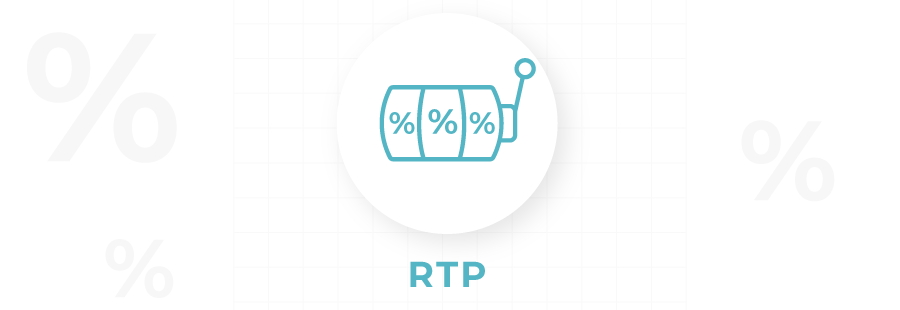
This is the first criterion of choosing a slots game, if the RTP information is available – the higher the RTP, the better, since this indicator express the payback percentage. Usually online slots have higher RTPs than those in land-based casinos.
Volatility

Assuming that volatility of a game is known or at least labeled as low, medium or high, it may stand as a criterion of choosing a slots game and the factors that this criterion is related to are the bankroll and intended limit of playing time.
For a player with a low bankroll, it may be useful to start with a low-volatility game so that possible constant winnings can consolidate the bankroll enough to move then to medium- or high-volatility games in which to chase higher prizes.
A player with a large bankroll may choose to start with medium- or high-volatility games, but of course the other option is not excluded.
For a player deciding to play very long sessions regardless of their bankroll, the distinction between low- and high-volatility may not even count in choosing.
Players who also aim at progressive jackpots usually play with the highest stakes, since most progressives require maximum wagers to be eligible for the progressive jackpot amount.
Such a choice is not recommended when playing a high-volatility game with no progressive-jackpot goal, especially with a low bankroll.
Otherwise, it is better to choose machines with high RTP and high volatility if possible, for progressive systems where hitting the regular jackpot is required, and with low to medium volatility if other smaller base prizes are required.
Probabilities

Players who are more interested in the chances of winning the prizes in one spin rather than RTP or volatility, for instance those playing short to medium sessions can take the probability of the various winning combinations as their criterion of choosing a game.
Of course, this is possible only if the PAR sheets of or that particular information about the pool of games to choose from is available.
If we knew such probabilities, we would immediately compute the mathematical fairness of the prizes of the games and a new probability-related criterion of choosing would become applicable: between two games having about the same probabilities associated with the prizes, you should choose the fairest.
It is a natural criterion not necessarily for its ethical nature, but just because a fairer bet in condition of equal probability assumes a higher payout and implicitly a higher expected value.
In progressive slots, choosing for a higher probability of winning actually means to choose a small network of progressives for reducing your competition or to play in local networks when there is minimum number of players engaged.
Be aware
This choice is no longer valid if the size of the jackpot amount and not the probability of winning is the main criterion of choosing.
If this is the case, the player may choose to play in a wide-area network with unlimited jackpot.
Expected value

Players aiming at a strategy that optimizes expected value may choose the must-hit-by progressive systems, where the advantage play is applicable.
Such a choice is also related to other factors of personal play, such as intended length of the session and bankroll.
Keep in mind
There are various objective criteria of choosing a slots game, machine, or network, however there is no absolute strategy based on any recommendations for the choices. Choices are related to player’s own factors of play, including style and goals.
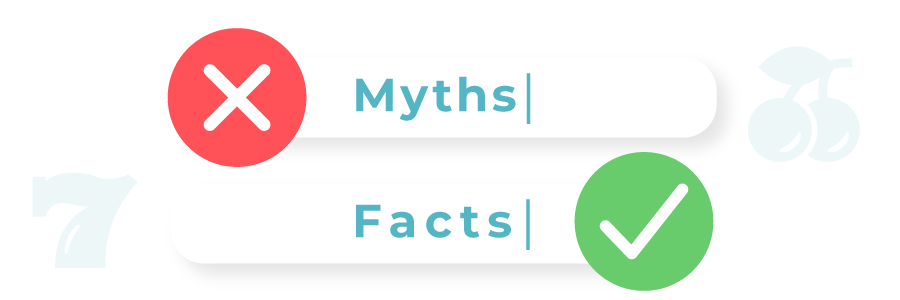
The high popularity of slots made this game over time a source of myths that circulate among players and are believed as true by many non-informed players.
Some of these myths subscribe to the general gambling misconceptions and fallacies and others are specific to slots; we have already mentioned them in this guide.
Since problem-gambling experts found slots to be the most addictive casino game, it is important to know about the main myths and about the associated facts that debunk them:
Myth 1: If you keep playing the same slot machine, it will eventually pay out.
Facts: Physically speaking, it is true.
But it is not a payout itself as an event that you should aim at, but to have an overall profit over that session and this amounts to the length of the losing streak.
Every unlucky spin costs you credits and the loss cumulates until the winning spin. For having a profit, the payout should exceed the cumulated loss and that depends on the prize you won.
On the other hand, your bankroll should be large enough to sustain a long losing streak. This stands for any game of chance.
No information about a machine will tell you for how long you should play it before it pays out.
All statistical indicators of a slots game – if available – are statistical averages and not arithmetical. After all, outcomes are determined by the RNG, which works randomly.
Frequency of wins is related to the probability of each winning combination, but probability is – again – an infinite average and cannot predict when precisely a win will occur. It is possible, although improbable, that a machine won’t pay out for thousands of spins ahead or more.
Myth 2: If you near missed a winning combination, it’s a sign that you will win soon.
Facts: Each combination of stops on the reels has the same probability of occurrence, but the various combinations of symbols have different probabilities. Besides, each spin is independent of the previous.
A near-miss is just a miss and gives no information about the future outcomes.
The near-miss may occur by chance, but also because the symbol weightings and mappings of the reels are usually manipulated by design to produce frequent combinations looking like near-misses, for fueling hope and making you to play more.
Myth 3: It is recommended to play at night for having greater chances of winning a progressive jackpot.
Facts: Obviously at night there are fewer players in a network than during the day. If we knew that the algorithm of triggering the jackpot does not involve the time factor, it would be true that chances are higher at night, since they decrease with the number of players in the network.
However, no one knows that algorithm except the producer’s staff.
It is possible that the triggering algorithm to be setup such that to trigger the jackpot during the day; nobody can exclude this possibility.
Even for must-hit-by progressives, where the algorithm is supposed to let the RNG choose only over a distribution of the values of the meter, we cannot know for sure if this is the only factor. Therefore playing at night does not worth the effort of trying to chase the jackpot, especially in those systems where hitting the regular jackpot is required to be eligible for the jackpot.
The probability of this latter event is low enough and the same whatever day or night.
Myth 3: If a machine has just paid out it is unlikely that it will pay out over the next coming spins. If a machine has not paid out for a long time, it is likely that it will pay out soon.
Facts: None of these statements are true, whatever the RTP and volatility of a machine.
Probability, RTP, variance, are all theoretical statistical averages that only materialize over the long run. It is physically possible for a machine to not pay out for any number of spins.
Besides, the spins are independent to each other and the RNG picks thousands of numbers per second of which only one determines the outcome. Every fraction of a second you delay in hitting the spin button results in a different outcome of the spin.
Therefore there is no rational reason for a player to be upset when someone hits a jackpot or other kind of prize on a machine they were just playing, nor to choose a machine just because it has not paid anything or has paid very low for a long period of time.
Myth 4: Any slot machine will eventually pay you back in the percentage indicated by its RTP if you don’t hit any prizes.
Facts: The RTP as a statistical average does not apply to your own play, but to all players’ activity at that machine, over the long run.
The payback of a slot machine is not distributed by any rule over one’s session of play and is not uniformly distributed over the long run over all spins, just like the winning outcomes are not.
Myth 5: By acting on the lever or on the spin button in certain way or at certain moment you can have some control over the outcomes
Facts: This illusion of control has nothing to do with how a slot machine works, whether we talk about mechanical, electro-mechanical or virtual-reel slots.
For mechanical slots, the features of their mechanism ensure the randomness of the outcomes.
For the RNG slots, it is the RNG that determines the outcome even prior to the moment when the spin button triggers the mechanical or virtual spin.
Conclusion
Slots are a special casino game with respect to transparency.
The parametric configuration of he game is kept secret by games’ producers and can only be retrieved through statistical tracking effort or by legal intervention. The inner design of the game of slots has parameters that can be manipulated at the moment of conception for producing artificial near-misses.
The statistical indicators of a game – wining odds, RTP-house edge, volatility – cannot be precisely estimated in the absence of the data regarding the parametric configuration of a game. The only indicators usually exposed are the RTP and volatility index.
These indicators can stand as criteria of choosing a game or another, but do not have any strategic role, except in the case of the must-hit-by progressives, where playing after the breakeven point is an expectation-based strategy where the RTP is involved along with the maximal value of the jackpot.
The probabilities of winning the regular jackpot and other top prizes are minute and the probability of hitting the progressive jackpot is even lower, in the order of 1 in millions to 1 in tens of millions or more.
Chasing a progressive jackpot is a risky choice, whatever strategy and bankroll used.
Slots are recognized by problem-gambling experts as the casino game having the highest potential of becoming addictive.
This is why a first requirement for a responsible play in slots is to get informed about how slots really work and how they are designed mathematically, for resisting all kind of specific illusions and misconceptions about the game.
References
- Bărboianu, C. (2013). The mathematics of slots: Configurations, combinations, probabilities. Craiova: Infarom.
- Bărboianu, C. (2019). The epistemology of the near miss and its potential contribution in the prevention and treatment of problem-gambling. Journal of Gambling Studies, Vol. 35, 1063-1078.
- Bărboianu, C. (2022). Understanding your game: A mathematician’s advice to rational and safe gambling. PhilScience Press.
- Beresford, K., & Blaszczynski, A. (2020). Return-to-player percentage in gaming machines: Impact of informative materials on player understanding. Journal of Gambling Studies, 36(1), 51-67.
- Harrigan, K. A. (2007). Slot machine structural characteristics: Distorted player views of payback percentages. Journal of Gambling Issues, Vol. 20, 215-234.
- Harrigan, K. A. (2008). Slot Machine Structural Characteristics: Creating Near Misses Using High Award Symbol Ratios. International Journal of Mental Health and Addiction, Vol. 6, 353-368.
- Harrigan, K. A., & Dixon, M. (2009). PAR Sheets, probabilities, and slot machine play: Implications for problem and non-problem gambling. Journal of Gambling Issues, Vol. 23, 81-110.
- Kilby, J., Fox, J. & Lucas, A. F. (2005). Casino Operations Management. Wiley.
- Turner, N. E., & Horbay, R. (2004). How do slot machines and other electronic gambling machines really work? Journal of Gambling Issues, Vol. 11.
- Turner, N. E. (2011). Volatility, house edge and prize structure of gambling games. Journal of Gambling Studies, 27(4), 607-623.

Bonuses
Casinos
Games
Academy
News
Shop
NEW Q&A
Sweepstakes


















































